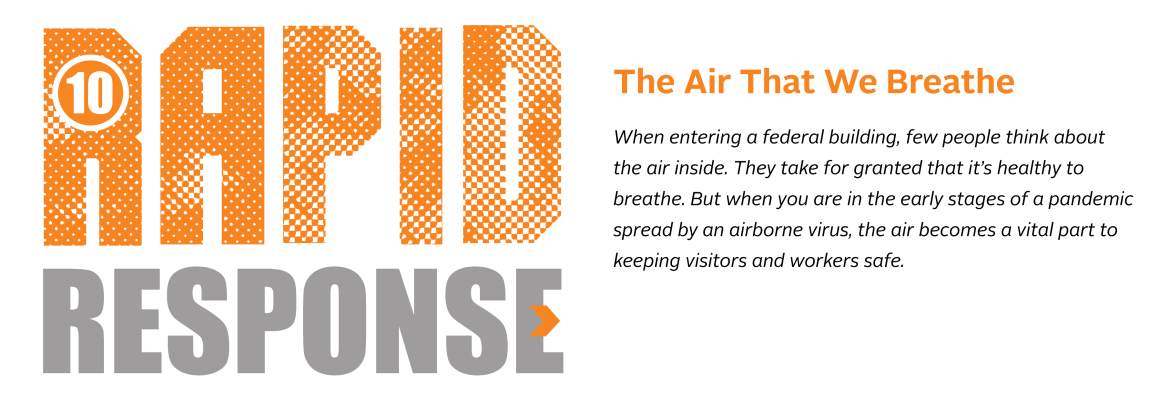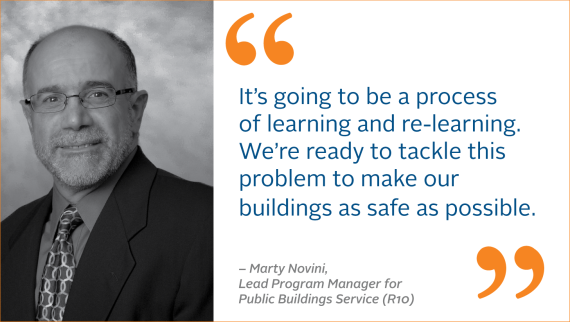R10 Rapid Response 2


Within hours of the first reported exposure to COVID-19 in a federal building, Northwest/Arctic Region teams were faced with more questions than they had answers to, and the calls came in non-stop from building managers searching for guidance.
The region set up several teams to handle the queries, while others sought guidance from the General Services Administration national office and the Centers for Disease Control and Prevention.
Marty Novini, Lead Program Manager for Public Buildings Service for Region 10, and his colleagues did their best to field those early questions about how to protect federal staff and visitors. One thing became clear, everyone wanted to know about the air.
“I was getting information on an hourly basis related to covid. It was overwhelming,” said Novini. “We gathered all the data we could and we passed it onto the other regions hoping to get everyone on the same page.”
Guidelines came in and the first significant measures indicated mask wearing and social distancing helped prevent air-borne droplets from possibly spreading the virus. While these measures were important, guidance also indicated air movement was equally important. Getting fresh air moving through the federal buildings was seen as a solid preventative action to take that could help reduce exposure risk.
Northwest/Arctic Region Industrial Hygienist Bob Bliss recalls how many came to the table to interpret these new guidelines. Design and construction staff, mechanical engineers, and facility managers came together to discuss how to best minimize exposure.
“We recognized one answer didn’t fit every situation and having all these professionals at the table helped us develop plans for different types of situations,” Bliss said.
Different federal buildings required different types of responses about how to alter the ventilation systems. Ceiling height, the number of rooms, and a multitude of other factors contributed to how teams put together plans.
Novini recalls how reliant teams became on information from the medical community regarding how the virus transmitted and how the new information constantly shaped GSA’s response to minimize building exposure.
Once GSA guidelines were established for operating air handling systems,they passed it along to building managers to carry out. Attention to ventilation systems and filtration became the focus. While some buildings weren’t occupied because of telework, others that had more visitors required a different approach.
“The courts, really any building that had high foot traffic, required us to look at those spaces differently to maintain a safe and healthy workplace,” added Bliss.
But it wasn’t just federal buildings. Many federal agencies rent space from private landlords, leaving the job of maintaining healthy air to breathe to someone else. Fortunately for Region 10, the lessors were more than willing to make adjustments to help ensure a healthy environment.
Mary Senn, Occupancy Administration Manager for GSA Region 10, worked with the lessors to develop guidelines for the rented federal spaces.
“Our lessors are like us, very concerned about the risk to visitors, themselves, and their staff,” Senn said. “We anticipated pushback, but I think our lessors were very thankful for the guidance and compensation offered by GSA to address the new requirements.”
The new requirements, which meant unilateral lease amendments for every national lease, included ventilation adjustments and surface disinfection. Because Region 10 first managed virus protocols for buildings, many of the processes developed in Region 10 became the standard for other regions as they began to deal with minimizing the spread of the virus.

This included activities such as a virtual lease inspection process where the lessor would literally walk through the property during an online video meeting showing the building and the measures being taken to minimize the spread of the virus.
“No one wanted to go onsite, but we had to ensure the terms of the lease were being followed, and this accomplished that,” Senn said. “Everyone rose to the occasion to make this happen.”
But the job isn’t done. As experts learn new information about the virus and how it’s spread, GSA teams create improved cleaning and ventilation methods of federal buildings and leased space to create safe and healthy environments for visitors and staff. These adjustments were all based on GSA teams following the CDC, the national GSA office, and the local and state guidelines for improved cleaning and ventilation methods.
“When there is a change nationally for these processes we have to disseminate that to everyone,” Senn added. “We recognize those changes are hard sometimes, but we’ve become good at flexing and adapting.”
Once the new processes are developed, Senn shares them with her leasing team, who then work with the specific lessors. At times, the constant changes were challenging to manage as they flowed through Senn and her team, then to the lessors through the Region 10 leasing administration managers.
“They are really the rockstars in all this,” Senn said of the leasing managers. “They were on the front lines communicating these changes with lessors sometimes on a daily basis.”
For Novini and his GSA colleagues managing the ventilation systems, being nimble is important as new information arrives that could alter their approach to keeping the air as clean as possible in federal buildings and federally leased space.
“It’s going to be a process of learning and re-learning over the next couple of years,” Novini said. “We’re ready to tackle this problem to make our buildings as safe as possible.”
Story by: Chad Hutson, Public Affairs Officer
Layout by: Cynthia Henry, Graphic Designer
Read more of the GSA “R10 Rapid Response” series:
- Part 1: R10’s Industrial Hygienist Looks Back Over a Demanding Year
- Part 2: The Air that We Breathe
- Part 3: ROB on the Move…Wait
- Part 4: Purchasing During a Pandemic
- Part 5: Managing the Emptiness

 U.S. General Services Administration
U.S. General Services Administration